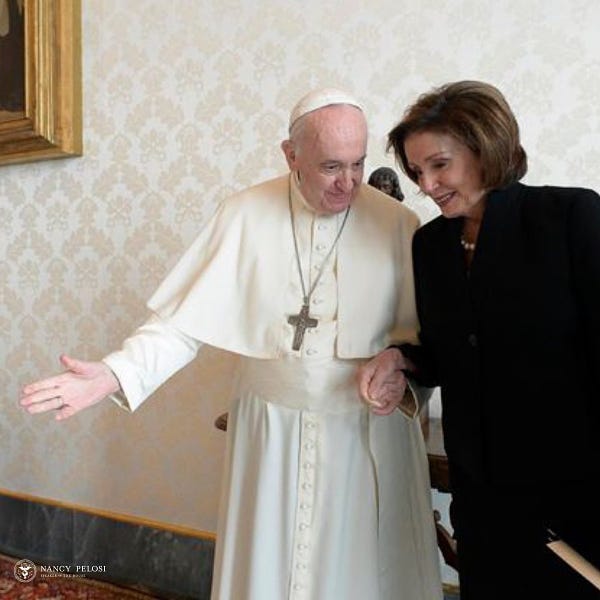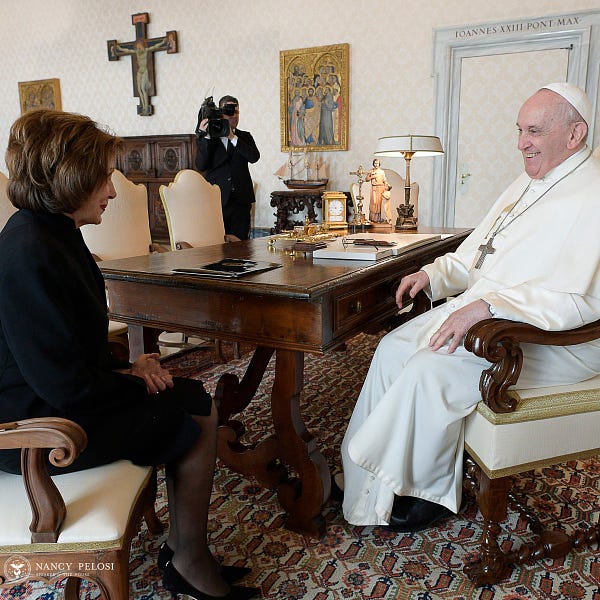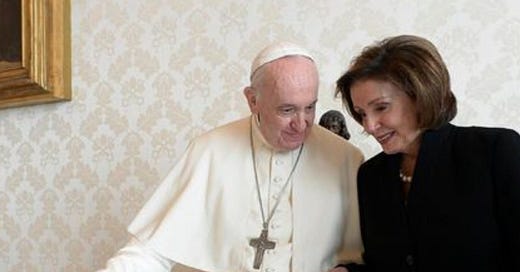
October might be the best month to visit Rome. The summer heat has broken, and the weather is perfect. The colors are starting to change. And the food — mushrooms, truffles, pumpkin, and broccoletti are in season, and wonderful.
U.S. House Speaker Nancy Pelosi visited Rome this month, and no doubt enjoyed some of those things. But the visit was also politically convenient for the congresswoman, and signaled how strained the triangulated relationship has become between the Holy See, pro-choice U.S. Catholic politicians, and the diocesan bishops charged with the care of their souls.



The speaker’s visit also foreshadowed how tense the next few weeks will be among ecclesiastical leaders, ahead of the U.S. bishops’ conference debate on a “Eucharistic coherence” document at their November meeting.
Pelosi’s trip — which included photo ops with Cardinal Peter Turkson and Pope Francis himself — will make difficult the ongoing effort of some bishops to call pro-choice Catholic politicians to conversion on abortion, and to respond with ecclesiastical discipline to Catholic lawmakers set on advancing legal protections for abortion in the U.S.
Her own diocesan bishop, Archbishop Salvatore Cordileone, has in recent months been outspoken about the possibility of prohibiting Pelosi from receiving the Eucharist, while making numerous public overtures in her direction.
In late September, the archbishop announced a prayer and fasting campaign, asking Catholics to fast weekly for Pelosi’s “conversion of heart,” to pray the rosary for her, and to register at a website that sends a single rose to Pelosi for each person committed to fasting and praying for her.
Cordileone is also among the principal supporters of the bishops’ proposed text on the Eucharist, and has urged that the section on “Eucharistic coherence” be direct about the incongruity between working to advance legal protection for abortion while receiving the Eucharist.
Pelosi’s bishop has, in short, become a leader of the movement among U.S. bishops to respond to the Biden administration’s abortion agenda with more direct pastoral and disciplinary engagement than has been typical of the bishops in recent decades.
With that in mind, some Catholics will ask if Pelosi’s photo call with Francis was an intentional papal rebuke of Cordileone’s approach, coming so soon after the archbishop launched his prayer and fasting campaign on her behalf, and wrote in the Washington Post about the importance of sacramental discipline.
It’s hard to say that definitively. But it does seem certain that bishops on both sides of the issue will take the visit as a message from Francis, especially because Pelosi’s meeting with the pope is not an isolated occasion. It came just after she met with Cardinal Peter Turkson, a Curial head who told Axios last week that he doesn’t think President Joe Biden should be denied the Eucharist — a prospect discussed by U.S. bishops, but not actually in the power of the conference to decide.
One Curial official told The Pillar this week that Turkson seemed “on maneuvers” ahead of the U.S. bishops meeting in November, aiming to push back on the possibility of a restrictive Eucharistic document.
Further, itt seems difficult to imagine that Francis was not briefed on Cordileone’s efforts before he met with Pelosi.
Of course, the pope meets with foreign leaders frequently, so it can be believed plausibly that his meeting with the House speaker in the Vatican on Saturday was not an effort to throw water on the bishops’ conference debate.
But the timing is remarkable, to say the least.
Whatever Pope Francis intended, it has been clearly a political strategy of both Biden and Pelosi to distract from conflict with U.S. bishops by pivoting to a more cordial relationship with the Vatican and Pope Francis. As neither the pope or his advisors will be unaware of that fact, the real question is whether the triangulation was solely the Congresswoman’s strategy, perhaps with help from Turkson, or whether the pontiff is making a point to signal his unhappiness with Cordileone and his confreres ahead of their November meeting.
If the pope does have in mind a corrective for the U.S. bishops on the Eucharist and abortion, things will become less ambiguous in the next few weeks. It seems unlikely that Francis will sit quietly on the sidelines ahead of the November meeting, if he wants to see the bishops’ document shelved before passage, or see it drop any possible allusion to politicians’ advocacy.
It is possible the U.S. apostolic nuncio will meet with the bishops privately before their November meeting begins. It is also possible Francis will give unambiguous direction to Archbishop Jose Gomez, USCCB president, during their in-person meeting ahead of the bishops’ conference meeting. If Gomez, who first floated the idea of a Eucharistic coherence document, publicly cools on the idea, it will be reasonable to assume the pope has intervened.
One step back from speculation on the choreography and coded messaging between Rome and the U.S. is a simple question: If the pope does want to intervene in the U.S. bishops’ document drafting process, why?
Francis made comments this month that many took to affirm that promotion of abortion places one outside the Church’s communion. And both Congress and the White House, led by Catholics, are doubling down on their own party’s commitment to expanding, not just entrenching, legal protections for abortion.
Moreover, the bishops promoting the proposed Eucharistic document say they hope it will be primarily a catechism on the Eucharist. And on sacramental discipline, that it will borrow language from a text Francis himself helped write when he was Archbishop of Buenos Aires.
Why would Pope Francis discourage a thing like that?
That question will be on the minds of several U.S. bishops in upcoming weeks. Some of them will say it’s a matter of prudence to avoid direct confrontation with politicians, others will say it’s the reinforcement of an accommodationist pastoral strategy that has proven to be a failure. In either case, it will also be clear that politics, of the ecclesiastical variety, are also at play.
While all this unfolds, bishops are not the only ones watching the Vatican’s overtures toward Pelosi. Ordinary Catholics are watching, as are their pastors. For some of them, November is a question about what the Church stands for, and who it stands beside.
Editor’s note: This analysis initially stated that Cordileone had written about Eucharistic discipline in the Wall Street Journal. It has been corrected to the Washington Post.






The fact of the matter is that this boils down to bishops saying one thing about church teaching but never actually doing anything to show that is indeed true and real. And it is beyond demoralizing and depressing for the faithful who actually do believe.
balanced article that is helpful for me. We don't need to try to read tea leaves to understand this is a strategy employed by both sides to keep the status quo of ignoring the death of the innocents. Following science, we know life begins at conception. Following science, we know abortion kills a human life. Following our spiritual sense, we know the evil one despises the fact that Jesus was from the womb of "woman.' Following our spiritual sense, we know because he cannot attack God directly, he attacks that whom God loves so dearly, His "little ones." May we pray to God for our own conversion as well as others.